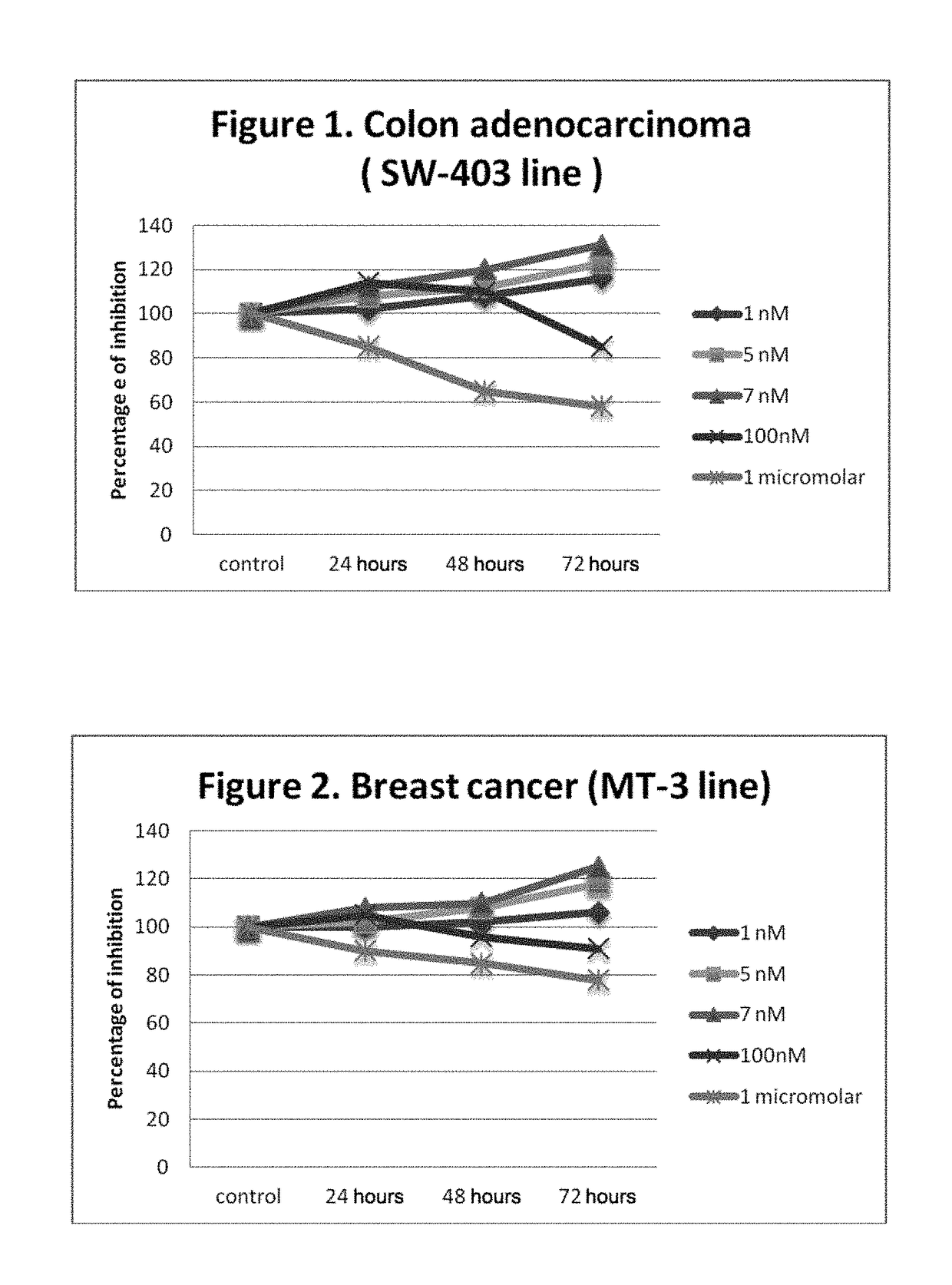Use of non-peptide nk1 antagonists in a predetermined dose for the treatment of cancer
a non-peptide nk1 receptor and predetermined dose technology, applied in the field of molecular biology applied to medicine, pharmacology and oncology, to achieve the effects of reducing tumour size, preventing their development, and facilitating their disappearan
- Summary
- Abstract
- Description
- Claims
- Application Information
AI Technical Summary
Benefits of technology
Problems solved by technology
Method used
Image
Examples
example 1
with Non-Peptide NK1 Receptor Antagonists, at Doses Between 10 and 80 mg Per Kilogram of Weight and Day, Reduces the Size of Cancerous Tumours of Epithelial Cell Line (Cancers) in Mammals
[0072]To verify that the administration of the antagonists not of the NK1 receptors, at doses between 10 and 80 mg per kilogram of weight and day, reduces the sizes of epithelial cell line tumours (cancers) in mammals, tumour cells were implanted in mice and were later treated with non-peptide NK1 receptor antagonists.
[0073]Immunocompromised female mice, 5-6 weeks of age were used, nu / nu Balb / c nude mice, provided by Harlan Iberica Barcelona (Spain). They were kept at 24° C. and in sterile conditions with food and water “ad libitum”. They were injected with 2×107 tumour cells, corresponding to cancer (human lung cancer, reference HCC-44 supplied by DSMZ) in 200 μl of PBS subcutaneous route. The tumour size was measured and the mice were evaluated for their state of health and weight daily. The mice ...
example 2
with Non-Peptide NK1 Receptor Antagonists, at Doses Between 10 and 80 mg Per Kilogram of Weight and Day, Reduces the Size of Cancerous Tumours of Glial Cell Line (e.g. Astrocytomas) of the Central Nervous System in Mammals
[0074]To verify that the administration of the antagonists not of the NK1 receptors, at doses between 10 and 80 mg per kilogram of weight and day, reduces the sizes of glial cell line tumours of the nervous system in mammals, tumour cells were implanted in mice and were later treated with non-peptide NK1 receptor antagonists.
[0075]Immunocompromised female mice, 5-6 weeks of age were used, in the same conditions as explained in example 1. They were injected with 2×107 tumour cells, corresponding to a glial cell line tumour of the central nervous system human (human glioma; reference GAMG; supplied by DSMZ) in 200 μl of PBS by subcutaneous route. The tumour size was measured and the mice were evaluated for their state of health and weight daily. The mice were randomi...
example 3
with Non-Peptide NK1 Receptor Antagonists, at Doses Between 10 and 80 mg Per Kilogram of Weight and Day, Reduces the Size of Cancerous Tumours of Mesenchymal Cell Line (Sarcomas) in Mammals
[0076]To verify that the administration of the antagonists not of the NK1 receptors, at doses between 10 and 80 mg per kilogram of weight and day, reduces the sizes of glial cell line tumours of the nervous system in mammals, tumour cells were implanted in mice and were later treated with non-peptide NK1 receptor antagonists.
[0077]Immunocompromised female mice, 5-6 weeks of age were used, in the same conditions as explained in example 1. They were injected with 2×107 tumour cells, corresponding to a mesenchymal cell line tumour (human fibrosarcoma; reference HT-1080; supplied by DSMZ) in 200 μl of PBS by subcutaneous route. The tumour size was measured and the mice were evaluated for their state of health and weight daily. The mice were randomized in nine groups when the tumours reached a volume o...
PUM
| Property | Measurement | Unit |
|---|---|---|
| Weight | aaaaa | aaaaa |
| Weight | aaaaa | aaaaa |
| volume | aaaaa | aaaaa |
Abstract
Description
Claims
Application Information
 Login to View More
Login to View More - R&D
- Intellectual Property
- Life Sciences
- Materials
- Tech Scout
- Unparalleled Data Quality
- Higher Quality Content
- 60% Fewer Hallucinations
Browse by: Latest US Patents, China's latest patents, Technical Efficacy Thesaurus, Application Domain, Technology Topic, Popular Technical Reports.
© 2025 PatSnap. All rights reserved.Legal|Privacy policy|Modern Slavery Act Transparency Statement|Sitemap|About US| Contact US: help@patsnap.com



